Boxer
Dogs
Boxer
| Boxer |
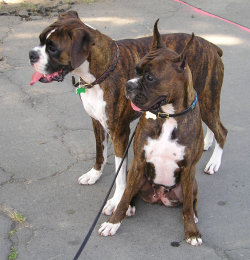
Brindle boxers with natural and cropped ears
|
| Alternative names |
German Boxer
Deutscher Boxer |
| Country of origin |
|
Germany |
| Common nicknames |
| |
| Classification and breed standards |
|
FCI: |
Group 2 Section 2 #144 |
|
|
AKC: |
Working |
|
|
ANKC: |
Group 6 (Utility) |
|
|
CKC: |
Group 3 - Working Dogs |
|
|
KC (UK): |
Working |
|
|
NZKC: |
Utility |
|
|
UKC: |
Guardian Dogs |
|
| Not recognized by any major kennel club |
| This breed of dog is
extinct |
| Notes |
| |
Boxers are a
breed of
stocky, medium-sized, short-haired
dog with a smooth
fawn or brindled coat and square-jawed muzzle. Boxers have very strong
jaws and a powerful
bite.
History
The ancestors of this breed were the
German
Bullenbeisser, a dog of Mastiff decent, and the
English Bulldog. The Bullenbeisser had been working as a hunting dog for
centuries, employed in the pursuit of bear,
wild boar,
and deer. Its task was to seize the prey and hold it until the hunters arrived.
In later years, faster dogs were favoured and the Bullenbeisser grew smaller and
was then called the Brabanter.
In the late 19th century, the Brabanter was crossed with an English Bulldog
to start the line that would become the modern Boxer. In 1894, three Germans by
the name of Roberth, Konig, and Hopner decided to stabilise the breed and put it
on exhibition at a dog show. This was done in
Munich in 1895,
and the next year they founded the first Boxer Club.
The breed was introduced to other parts of
Europe in the
late 1800s and to the
United States around the turn of the century. The
American Kennel Club (AKC)
recognised the first Boxer champion in
1915.
During
World War I, the Boxer was co-opted for military work, acting as a valuable
messenger dog, pack-carrier, attack dog, and guard dog.
It was not until after
World
War II that the Boxer became popular around the world. Boxer mascots, taken
home by returning soldiers, introduced the dog to a much wider audience and it
soon became a favourite as a companion animal, as a show dog, and as a guard
dog.
The name "Boxer" is supposedly derived from this breed of dog beginning a
fight by standing on its two hind legs and "boxing" with its two front paws.
Appearance
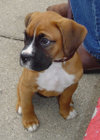 Three-month-old fawn Boxer puppy with uncropped ears
Three-month-old fawn Boxer puppy with uncropped ears
An adult boxer typically weighs between 25 and 32 kg (55 and 70 lb). Adult
male boxers are between 57 and 63 cm (23 to 25 in.) tall at the
withers;
adult female are between 53 and 60 cm (21 to 23 ˝ in.).
Cropping of
the tail remains popular, although cropping the ears is now prohibited in most
European breed standards and is slowly becoming banned in many other countries.
In color, boxers are typically either fawn or
brindled with
a white underbelly and white on the front or all four feet. The whiteness,
called 'flashiness,' often extends onto the shoulders or face. Conversely, some
brindled boxers are so dark as to appear black. In the UK, fawn boxers are
typically richer in color and are called "Red".
Some boxers are entirely white. Contraty to popular opinion, white boxers are
neither albino
(lacking pigment in the skin and eyes), nor rare. Some studies indicate that as
many as 25% of all boxers are white.
Boxers have a severe
underbite, and as a result, their lower row of teeth can get caught in their
jowls.
Temperament
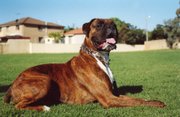 A brindle male at nearly 2 years.
A brindle male at nearly 2 years.
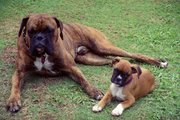 A one-year-old brindle and a 2-month-old fawn Boxer.
A one-year-old brindle and a 2-month-old fawn Boxer.
The character of the Boxer is of the greatest importance and demands the most
careful attention. He is renowned from olden times for his great love and
faithfulness to his master and household, his alertness, and fearless courage as
a defender and protector. The Boxer is docile but distrustful of strangers. He
is bright and friendly in play but brave and determined when roused. His
intelligence and willing tractability, his modesty, and cleanliness make him a
highly desirable family dog and cheerful companion. He is the soul of honesty
and loyalty. He is never false or treacherous even in his old age.
Boxers are a bright, energetic and playful breed and tend to be very good
with children. It's best if obedience training is started early since they also
have a strong personality and therefore can be harder to train when older. It is
also equally true that Boxers have a very long puppyhood and adolescence. They
are not considered fully mature until age three, one of the longest times in
dogdom, and thus need the early training to keep their high energy from wearing
the owner out. Boxers have unfairly earned a slight reputation of being
'headstrong'; no doubt due to some poorly obedience-trained examples of Boxers.
Attitude to:
Owners: Affectionate, devoted.
Children: Playful, exuberant (may be too much for very young children).
Other Pets: Good if raised with them.
Strangers: Protective of their family, Friendly if well socialised.
Unfamiliar Dogs: Can be problematic unless well socialised.
(Bailey 231)
Health
- Main articles:
Dog
health
Boxers can develop "cancers,
progressive retinal atrophy, torsion (bloat),
epilepsy, bleeding disorders, intestinal problems" (Bailey 37), heart
murmurs and ailments of the joints, such as
arthritis
and
hip dysplasia, although most good breeders test their breeding stock before
breeding and the incidence is slowly decreasing. White boxers have a tendency to
develop
deafness at a rate much higher than other boxers. Some studies indicate
30-40% of all white boxers are deaf in one or both ears. Since white boxers are
not albinos but
simply have a white coat, they have no added risk of skin
cancer as
compared to other boxers.
Uses
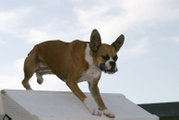 Fawn boxer doing
dog
agility Aframe with uncropped ears flying
Fawn boxer doing
dog
agility Aframe with uncropped ears flying
Boxers are friendly, lively companions that are often used as family dogs,
although they are also used as
guard dogs.
They also sometimes appear at
dog
agility trials and
flyball.
Before
dog fighting was made illegal, Boxers were often used in dog fights. These
strong and intelligent animals have even been sometimes used as
guide dogs
for the blind and
police dogs
in K9 units in place of the typical
German Shepherd.
External links
References
So You Wanna
Choosing the Right Dog for You by
Gwen Bailey
List of dog fighting breeds
Home | Up | Bandog | Barbet | Basenji | Basset Fauve de Bretagne | Basset Hound | Bavarian Mountain Hound | Beagle | Bearded Collie | Beauceron | Bedlington Terrier | Belgian Shepherd Dog | Belgian Shepherd Dog (Groenendael) | Belgian Shepherd Dog (Laekenois) | Belgian Shepherd Dog (Malinois) | Belgian Shepherd Dog (Tervueren) | Bergamasco | Berger Blanc Suisse | Bernese Mountain Dog | Bichon Frisé | Biewer | Black Russian Terrier | Black and Tan Coonhound | Bloodhound | Bluetick Coonhound | Boerboel | Border Collie | Border Terrier | Borderjack | Borzoi | Bosnian Tornjak | Boston Terrier | Bouvier des Flandres | Boxer | Boykin Spaniel | Brazilian Terrier | Briard | Brittany | Bull Terrier | Bull Terrier (Miniature) | Bull and Terrier | Bulldog | Bullmastiff | Bully Kutta
Dogs, made by MultiMedia | Free content and software
This guide is licensed under the GNU
Free Documentation License. It uses material from the Wikipedia.
|




